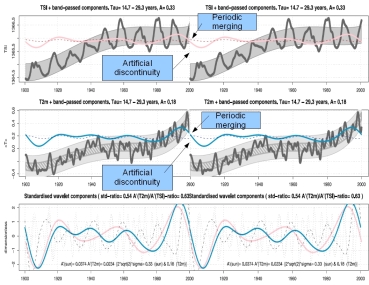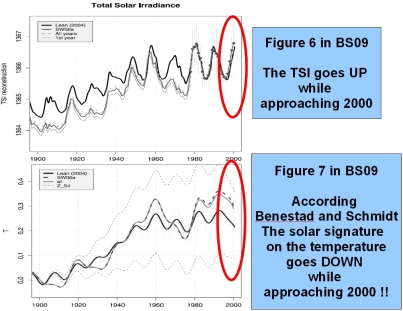On July 22 2009 I posted on the new paper on solar forcing by Lean and Rind 2009 (see). In that post, I also referred to the Benestad and Schmidt 2009 paper on solar forcing which has a conclusion at variance to that in the Lean and Rind paper.
After the publication of my post, Nicole Scafetta asked if he could present a comment (as a guest weblog) on the Benestad and Schmidt paper on my website, since it will take several months for his comment to make it through the review process. In the interests of presenting the perspectives on the issue of solar climate forcing, Nicola’s post appears below. I also invite Benestad and Schmidt to write responses to the Scaftta contribution which I would be glad to post on my website.
GUEST WEBLOG BY NICOLA SCAFETTA
Benestad and Schmidt have recently published a paper in JGR. (Benestad, R. E., and G. A. Schmidt (2009), Solar trends and global warming, J. Geophys. Res., 114, D14101, doi:10.1029/2008JD011639).
This paper criticizes the mathematical algorithms of several papers that claim that the temperature data show a significant solar signature. They conclude that such algorithms are “nonrobust” and conclude that “the most likely contribution from solar forcing a global warming is 7 ± 1% for the 20th century and is negligible for warming since 1980.”
By using the word “robust” and its derivates for 18 times, Benestad and Schmidt claim to disprove two categories of papers: those that use the multilinear regression analysis [Lean and Rind, 2008; Camp and Tung, 2007; Ingram, 2006] and those that present an alternative approach [Scafetta and West, 2005, 2006a, 2006b, 2007, 2008]. (See the references in their paper.)
Herein, I will not discuss the limitation of the multilinear regression analysis nor the limits of Benestad and Schmidt’s critique to those papers. I will briefly focus on Benestad and Schmidt’s criticism to the papers that I coauthored with Dr. West. I found Benestad and Schmidt’s claims to be extremely misleading and full of gratuitous criticism due to poor reading and understanding of the data analysis that was accomplished in our works.
Let us see some of these misleading statements and errors starting with the less serious one and ending with the most serious one:
1. Since the abstract Benestad and Schmidt claim that they are rebutting several our papers [Scafetta and West, 2005, 2006a, 2006b, 2007, 2008]. Already the abstract is misleading. Indeed, their criticism focuses only on Scafetta and West [2005, 2006a]. The other papers used different data and mathematical methodologies.
2. Benestad and Schmidt claim that we have not disclosed nor detailed the mathematical methodology and some parameters that we use. For example:
a) In paragraph 39 Benestad and Schmidt criticize and dismiss my paper with Willson [2009] by claiming that we “did not provide any detailed description of the method used to derive their results, and while they derived a positive minima trend for their composite, it is not clear how a positive minima trend could arise from a combination of the reconstruction of Krivova et al. [2007] and PMOD, when none of these by themselves contained such a trend).” However, the arguments are quite clear in that paper and in the additional figures that we published as supporting material. Moreover, it is not clear to me how Benestad and Schmidt could conclude that our work is wrong if Benestad and Schmidt acknowledge that they have not understood it. Perhaps, they just needed to study it better.
b) In paragraph 41 Benestad and Schmidt claim that: “It is not clear how the lagged values were estimated by Scafetta and West [2006a]”. However, in paragraph 9 of SW06a it is written “we adopt the same time-lags as predicted by Wigley’s [1988, Table 1] model.” So, again, Benestad and Schmidt just needed to study better the paper that they wanted to criticize.
c) In paragraph 48 Benestad and Schmidt claim that: “over the much shorter 1980-2002 period and used a global surface temperature from the Climate Research Unit, 2005 (they did not provide any reference to the data nor did they specify whether they used the combined land-sea data (HadCRUT) or land-only temperatures (CRUTEM).” However, it is evident from our work SW05 that we were referring to the combined land-sea data which is properly referred to as “global surface temperature” without any additional specification (Land or Ocean, North or South). We also indicate the webpage where the data could be downloaded.
d) In paragraph 57 Benestad and Schmidt claim that: “The analysis using Lean [2000] rather than Scafetta and West’s own solar proxy as input is shown as thick black lines.” However, in our paper SW06a it is crystal clear that we too use Lean’s TSI proxy reconstruction. In particular we were using Lean 1995 which is not very different from Lean 2000. Benestad and Schmidt apparently do not know that since 1978 Lean 1995 as well as Lean 2000 do not differ significantly from PMOD because PMOD was build (by altering the published TSI satellite data) by using Lean 1995 and Lean 2000 as guides. Moreover, we also merge the Lean data with ACRIM since 1978 to obtain an alternative scenario, as it is evident in all our papers. The discontinuity problem addressed by Benestad and Schmidt in merging two independent sequences (Lean’s proxy model and the ACRIM) is not an issue because it is not possible to avoid it given the fact that there are no TSI satellite data before 1978.
3. In Paragraphs 48-50 Benestad and Schmidt try to explain one of our presumed major mathematical mistakes. Benestad and Schmidt’s states: “A change of 2*0.92 W/m2 between solar minimum and maximum implies a change in S of 1.84 W/m2 which amounts to 0.13% of S, and is greater than the 0.08% difference between the peak and minimum of solar cycle 21 reported by Willson [1997] and the differences between TSI levels of the solar maxima and minima seen in this study (~1.2 W/m2; Figure 6).” Benestad and Schmidt’s are referring to our estimate of the amplitude of the solar cycle referring to the 11-year modulation that we called A7,sun = 0.92 W/m2 in SW05. Benestad and Schmidt are claiming that our estimate is nor reasonable because in their opinion according to our calculations the change of TSI between solar maximum and solar minimum had to be twice our value A7,sun , so they write 2*0.92=1.84 W/m2, and this would be far too large. However, as it is evident from our paper and in figure 4a in SW05 the value A7,sun refers to the peak-to-trough amplitude of the cycle, so it should not be multiplied by 2, as Benestad and Schmidt misunderstood. This is crystal clear in the factor ½ before the equation f(t)= ½ A sin(2pt) that we are referring to and that Benestad and Schmidt also report in their paragraph 48. It is hard to believe that two prominent scientists such as Benestad and Schmidt do not understand the meaning of a factor ½! So, again, Benestad and Schmidt just needed to think more before writing a study that criticizes ours.
4) Finally, Benestad and Schmidt’s paper is full of misleading claims that they are reproducing our analysis. Indeed, Benestad and Schmidt’s paper is self-contradictory on this crucial issue. In paragraph 85 Benestad and Schmidt claim that they “have repeated the analyses of Scafetta and West, together with a series of sensitivity tests to some of their arbitrary choices.” However, in their paragraph 76 Benestad and Schmidt acknowledge: “In our emulation, we were not able to get exactly the same ratio of amplitudes, due to lack of robustness of the SW06a method and insufficient methods description.” It is quite singular that Benestad and Schmidt claim to have repeated our calculation, at the same time they acknowledge that, indeed, they did not succeed in repeating our calculation and, ironically, they blame us for their failure. It is not easy to find in the scientific literature such kind of tortuous reasoning!
In fact, the reason why Benestad and Schmidt did not succeed in repeating our calculation is because they have misapplied the wavelet decomposition algorithm known as the maximum overlap discrete wavelet transforms (MODWT). This is crystal clear in their figures 4 where it is evident that they applied the MODWT decomposition in a cyclical periodic mode. In other words they are implicitly imposing that the temperature in 2001 is equal to the temperature in 1900, the temperature in 2002 is equal to the temperature in 1901 and so on. This is evident in their figure 4 where the decomposed blue and pink component curves in 2000 just continue in 1900 in an uninterrupted cyclical periodic mode as shown in the figure below which is obtained by plotting their figure 4 side by side with itself:
Any person expert in time series processing can teach Benestad and Schmidt that it is not appropriate to impose a cyclical periodic mode to a non stationary time series such as the temperature or TSI records that present clear upward trends from 1900 to 2000. By applying a cyclical periodic mode Benestad and Schmidt are artificially introducing two large and opposite discontinuities in the records in 1900 and 2000, as the above figure shows in 2000. These large and artificial discontinuities at the two extremes of the time sequence disrupt completely the decomposition and force the algorithm to produce very large cycles in proximity of the two borders, as it is clear in their figure 4. This severe error is responsible for the fact that Benestad and Schmidt find unrealistic values for Z22y and Z11y that significantly differ from ours by a factor of three. In their paragraph 50 they found Z22y = 0.58 K/Wm-2, which is not realistic as they also realize later, while we found Z22y = 0.17 K/Wm-2, which is more realistic.
This same error in data processing also causes the reconstructed solar signature in their figures 5 and 7 to present a descending trend minimum in 2000 while the Sun was approaching one of its largest maxima. Compare their figures 4a (reported above), 5 and 7 with their figure 6 and compare them also with our figure 3 in SW06a and in SW08! See figure below where I compare Benestad and Schmidt’s figures 6 and 7 and show that the results depicted in their Figure 7 are non-physical.
Because of the severe and naïve error in applying the wavelet decomposition, Benestad and Schmidt’s calculations are “robustly” flawed. I cannot but encourage Benestad and Schmidt to carefully study some book about wavelet decomposition such as the excellent work by Percival and Walden [2000] before attempting to use a complex and powerful algorithm such as the Maximum Overlap Discrete Wavelet Transform (MODWT) by just loading a pre-compiled computer R package.
There are several other gratuitous claims and errors in Benestad and Schmidt’s paper. However, the above is sufficient for this fast reply. I just wonder why the referees of that paper did not check Benestad and Schmidt’s numerous misleading statements and errors. It would be sad if the reason is because somebody is mistaking a scientific theory such as the “anthropogenic global warming theory” for an ideology that should be defended at all costs.
Nicola Scafetta, Physics Department, Duke University


